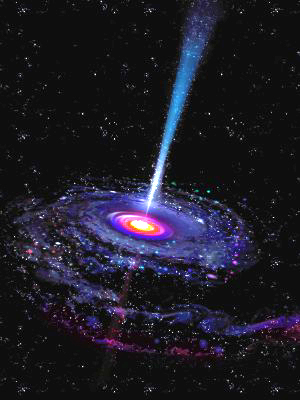Black hole: Difference between revisions
imported>Subpagination Bot m (Add {{subpages}} and remove any categories (details)) |
imported>Mark Widmer (Added section "Detection and Observation of Black Holes". Added paragraphs on gravitational-wave detection and the 2019 image from the Event Horizon Telescope.) |
||
| Line 10: | Line 10: | ||
According to [[quantum mechanics]], the location of the matter within a black hole is [[quantum uncertainty|uncertain]]. Additionally, a phenomenon called Hawking radiation predicts that black holes can "leak" a very small amount of mass. So theoretically, black holes are not truly "black" due to emitted radiation. Black holes have a surface temperature defined by their mass. The larger the [[mass]] of a black hole, the larger the diameter, and the lower the amount of energy which escapes, thus the lower the temperature, and the longer the time it takes for the black hole to "evaporate". | According to [[quantum mechanics]], the location of the matter within a black hole is [[quantum uncertainty|uncertain]]. Additionally, a phenomenon called Hawking radiation predicts that black holes can "leak" a very small amount of mass. So theoretically, black holes are not truly "black" due to emitted radiation. Black holes have a surface temperature defined by their mass. The larger the [[mass]] of a black hole, the larger the diameter, and the lower the amount of energy which escapes, thus the lower the temperature, and the longer the time it takes for the black hole to "evaporate". | ||
=== Detection and Observation of Black Holes === | |||
Methods of detecting and observing black holes include imaging using radio telescopes and also gravitational wave detection. | |||
In 2015, the two LIGO (Laser Interferometer Gravitational-Wave Observatory) detectors in the USA made the first-ever detection of gravitational waves, which were emitted by two colliding black holes. Since then, the Virgo detector in Italy has also contributed to gravitational wave detection. | |||
In 2019, a direct image of a black hole was made using the Event Horizon Telescope, which is actually a worldwide network of radio telescopes. | |||
Revision as of 20:26, 8 October 2020

A black hole is an object in spacetime which has an escape velocity greater than c, the speed of light. Since light cannot escape, the object absorbs all light, hence the term black.
Black holes are thought to be the result of collapsing matter following the explosion of large stars into supernovae. For a star to be capable of compaction into a singularity, it must have a mass greater than 3.4 times that of the Sun. Specifically, if the remnants of a star which has exhausted the energy available from nuclear fusion reactions are greater than about 3.4 times the mass of the sun, electron degeneracy and neutron degeneracy are insufficient to prevent the star from collapsing into a black hole. Recent cosmology has considered the possibility of smaller black holes forming in the very early history of the universe, due to fluctuations in mass distribution when the density of the universe was significantly higher than is observed now.
There are both rotating and stationary black holes, a singularity and event horizon(s) being the major features of both. The event horizon is the boundary of a black hole where gravitational forces become so strong that not even light can escape. Relativity states that the singularity is a point of infinite space time curvature, and the singularity of a black hole is covered by the event horizon. To an outside observer, objects falling into a black hole will take an infinite amount of time to reach the event horizon. However, the amount of time as measured by the object falling into the black hole can be very short. A rotating black hole, according to the Kerr solutions of general relativity, will have two event horizons, and there are spacetime paths through the event horizon which do not intersect the singularity.
According to quantum mechanics, the location of the matter within a black hole is uncertain. Additionally, a phenomenon called Hawking radiation predicts that black holes can "leak" a very small amount of mass. So theoretically, black holes are not truly "black" due to emitted radiation. Black holes have a surface temperature defined by their mass. The larger the mass of a black hole, the larger the diameter, and the lower the amount of energy which escapes, thus the lower the temperature, and the longer the time it takes for the black hole to "evaporate".
Detection and Observation of Black Holes
Methods of detecting and observing black holes include imaging using radio telescopes and also gravitational wave detection.
In 2015, the two LIGO (Laser Interferometer Gravitational-Wave Observatory) detectors in the USA made the first-ever detection of gravitational waves, which were emitted by two colliding black holes. Since then, the Virgo detector in Italy has also contributed to gravitational wave detection.
In 2019, a direct image of a black hole was made using the Event Horizon Telescope, which is actually a worldwide network of radio telescopes.